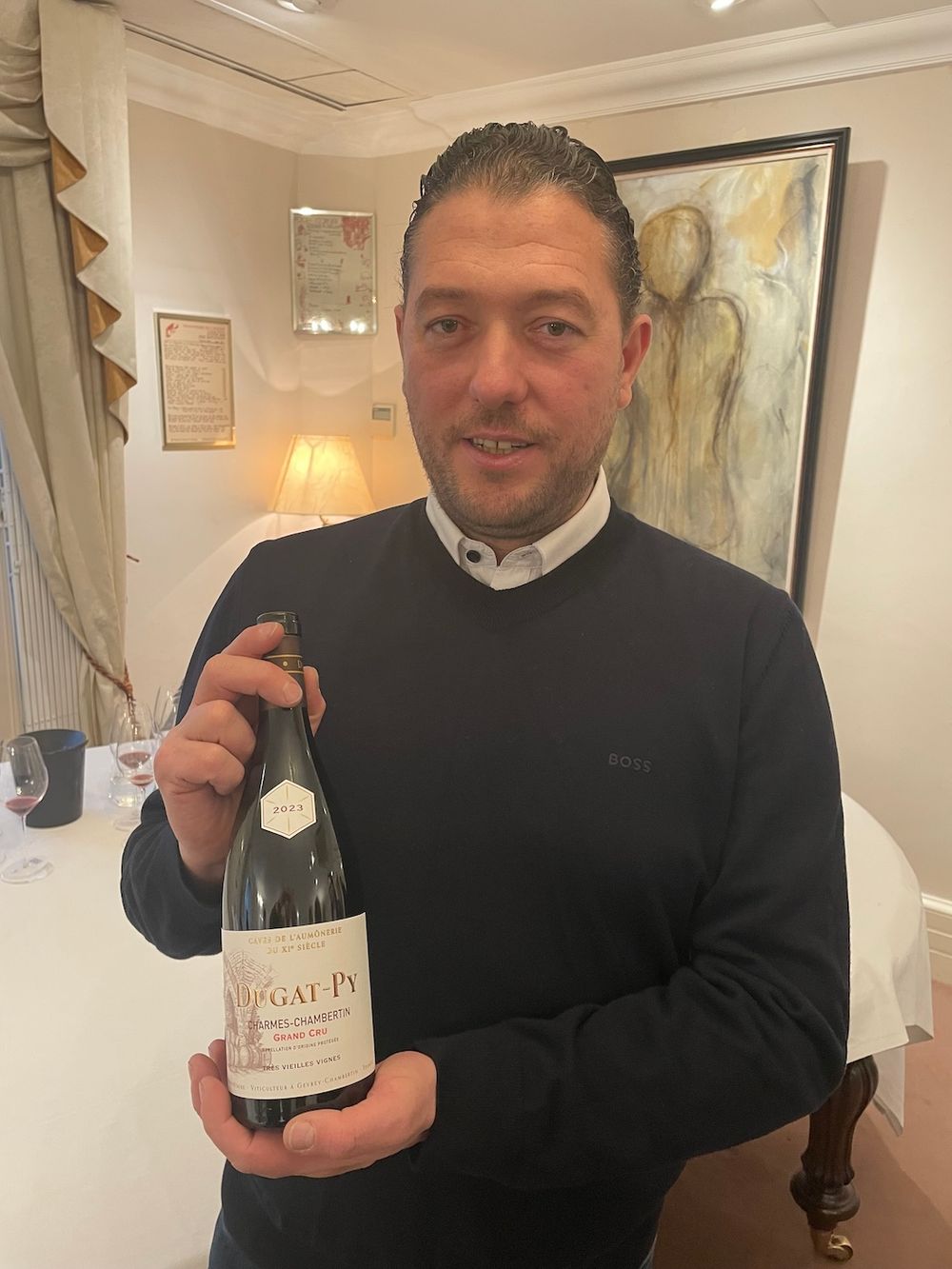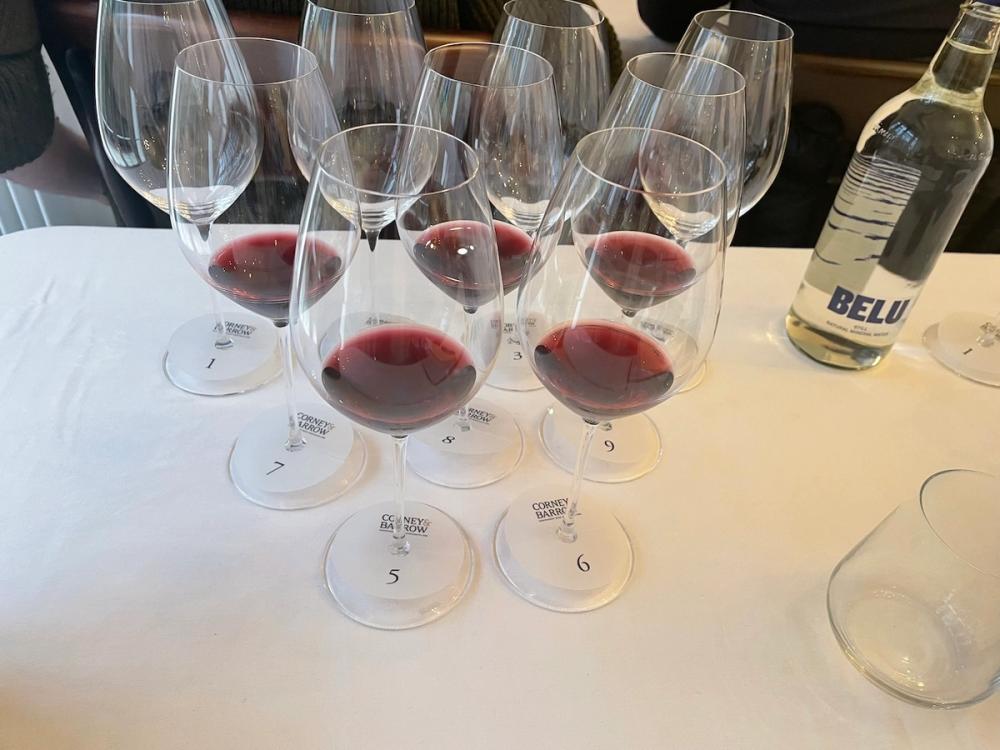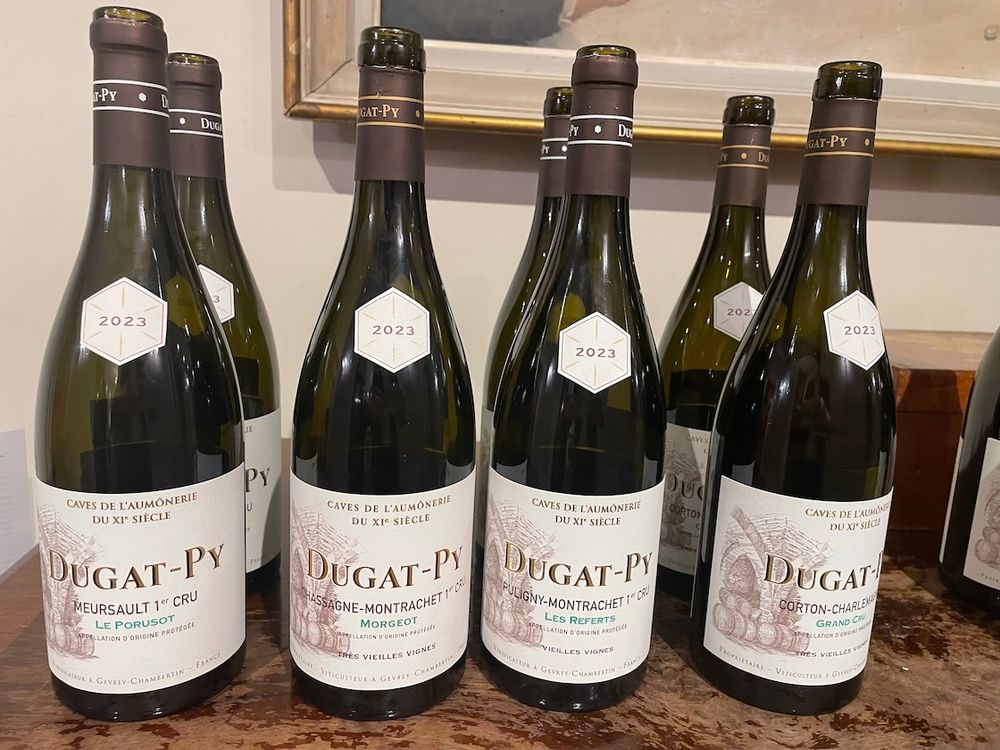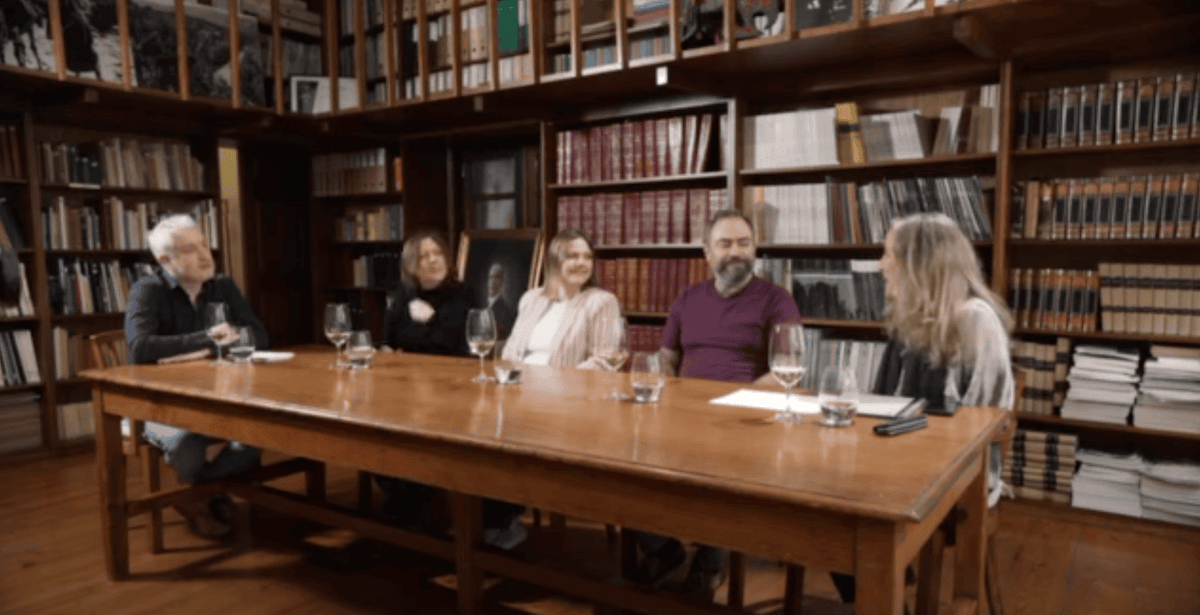As the thirteenth generation to oversee his family’s revered Gevrey-Chambertin domaine, Loïc Dugat is not about to impose a bout of voguish “disruption” on the firm. But he is not above some serious tweaking of the wines either. At his unveiling of the 2023 vintage at Corney & Barrow’s London office, something that is now an annual event, it’s evident that he is continuing to take the style in a new direction. It’s also clear that under his stewardship, Dugat-Py is on the acquisition trail in Burgundy and making itself an established presence in white wines.

“I try to get the concentration out of the old vines while keeping freshness.” Loïc Dugat shows off the Dugat-Py 2023 wines
The estate has 15 ha, spread over more than 20 top appellations and makes over 30 distinct wines. It boasts some venerably old vines, many over a century old.
The weather two growing seasons ago was hot and sunny. It was, in fact, “a heatwave”, Dugat tells us. So how are the 2023 wines, most ready to drink in two to three years (but many of which will only peak in the early 2030s) showing?
We start off with a crowd-pleaser, the Bourgogne Halinard. Like all the wines at the tasting, it has an alcohol by volume of between 12.5% and 13.2% - a modest, comfortable level. A comparatively affordable red (£395 a case of six bottles in bond), this is a Gevrey-Chambertin from the lower slopes that the estate has asked to be declassified to Bourgogne Rouge status.
It’s described as a flinty, spicy delight. Though not one of the more complex wines, it has a lovely length and truly wonderful mellow fruit with a good refreshing acidity. It spends 12-18 months in oak barrels, 10% new, with 50% whole bunch fermentation. It is generous to a fault. Although it is not recommended for drinking for another three years, over-eager folk who whip out the corkscrew now won’t be disappointed.
Moving on to the more ‘serious’ reds, we find them quite closed at the moment. This is particularly true of the Gevrey-Chambertin Cuvée Coeur de Roy Vieilles Vignes (£795 a case of six) made from vines between 50 and 115 years old from four plots. The largest volume cuvée at the estate, this is one of the flagship wines that Dugat works hardest on – and it reveals the new direction he is headed in.
“I try to get the concentration out of the old vines while keeping freshness,” he explains. Indeed, freshness, purity and elegance are very much the watchwords at the domaine since Loïc and his wife Marie-Amélie took over complete responsibility for winemaking in 2014. This makes the wines pleasingly more contemporary in style in some hard-to-define way.
New directions

Underpinning the domaine’s working practices are a shift to organic in 2003, the introduction of horses for ploughing three years later and changes to trellising techniques in four grand crus and premier crus plots twelve years after that.
But the latest tweaks include two other significant steps. First is less use of oak and the second is more whole bunch fermentation. The Coeur de Roy, for example, is 20% new oak and 75% whole bunch fermentation. All of this is done in the name of expressing the terroir of the small plots as well as possible.
“The aim is that you can sense the whole-bunch fermentation but that it is not dominant,” says Dugat.
For those with deeper pockets, the focus may be on the Gevrey-Chambertin 1er Cru Lavaux St-Jacques Vieilles Vignes (£2,050 for a case of six). Once again, 75% whole bunch fermentation but with slightly higher 30% of new oak, this comes from one of the domaine’s tiny plots of just 0.14 ha from vines between 45 and 65 years old.
Such a wine from only two harvests ago is inevitably a work in progress, it should be laid down for another four years at least and won’t be past its peak for another 20 (if that). Even so, the characteristic raspberry and blackberry notes are already to the fore and the beginnings of an awesome structure coupled with a noteworthy delicacy.
Increasing amount of whites

Moving on to the whites, we learn that these now comprise no less than 30% of the estate’s production. First up is the Meursault 1er Cru Les Porusots (£1,350 a case of six). Dugat quips that this was a brave choice for the tasting since it threatened to put the other whites in the shade. The Meursault is among several top-flight white appellations that the company has been gradually acquiring in over a couple of decades. The 2023 has yet to be racked and there is a hint of spritz to it. But the wine shows all the hallmarks of a classic Meursault with aromas of nectarine and ripe apricot. Dugat is looking for “energy” in the wine and wanted at all costs to avoid a big heavy wine.
With global warming, wines end up rich and heavy if you delay harvesting even slightly. In his pursuit of that sought-after freshness, Dugat was one of the first to harvest in 2023.
One suspects that Dugat has a soft spot for Puligny-Montrachet 1er Cru Les Referts (£1,350 for a case of six bottles). “I always think Referts deserves a higher profile,” he declares. “Although this is a négociant wine, the domaine team worked this plot and picked the grapes. This is clipped, focussed and classical, with lemon zest and stony minerality defying what might be expected from the 2023 warmth.” It has 10% new oak.
The priciest white is the Corton-Charlemagne Grand Cru (£1,495 for a case of just three bottles) comes from a minuscule plot of just a quarter of a hectare. It’s south west-facing from vines of about 50 years old. The Chardonnay creaminess presents very gently with green melon notes with a beautiful tension. With 20% new oak there are aromas of lime and melon. One taster sees it as “a ballet dancer hand in hand with a rugby player.”Maybe Dugat is a bit of a disrupter after all.
Corney & Barrow exclusively distributes Dugat-Py wines in the UK and Singapore. Corney & Barrow is a commercial partner of The Buyer. To discover more about them click here.
































